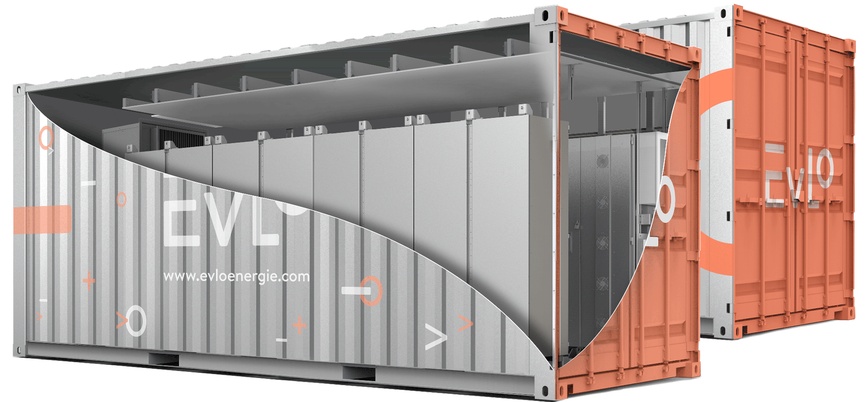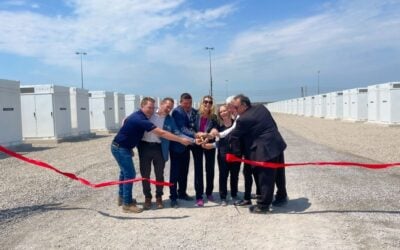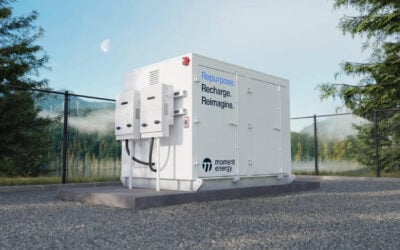
Quebec’s largest grid-scale battery energy storage system to date will maintain electricity supply and power quality for customers of Canadian utility company Hydro-Québec while it carries out major transmission line upgrade work in the province.
The public utility company and transmission system operator is replacing 60 wooden gantries with steel gantry cranes, rebuilding a 1.2km section of a 58km transmission line from a substation in La Vérendrye to the municipality of Parent and replacing essential equipment at more than 200 points.
Enjoy 12 months of exclusive analysis
- Regular insight and analysis of the industry’s biggest developments
- In-depth interviews with the industry’s leading figures
- Annual digital subscription to the PV Tech Power journal
- Discounts on Solar Media’s portfolio of events, in-person and virtual
Electricity supply for several hundred local residential and commercial customers in the municipality of Parent will be maintained using a 4MW / 20MWh battery energy storage system while the transmission network is out of action. Initial work including installation of the battery system is scheduled to take place from spring this year until spring 2022, but other maintenance work will take place all the way up to 2035 and the energy storage asset is expected to remain in place.
The local network will be islanded from the grid in a project that the utility said will also serve as a technological showcase of how decentralised sources of backup energy can be remotely integrated into the network during planned work and outages. Hydro-Québec operates more than 260,000km of transmission lines across its networks in total.
The battery system will also continue to be used on the grid as a means of managing peaks in demand after the initial work is done. Hydro-Québec said in a press release yesterday that the energy storage will improve service continuity to this remote region of northern Canada which is served by a single transmission line. Analysis firm BloombergNEF recently estimated that energy storage used for transmission and distribution services will be a market worth US$277 billion between 2020 and 2050, with falling battery costs making the technology competitive in relation to new power lines and serving to mitigate grid congestion.
“The Parent substation project will be the first energy storage system on our grid that will meet the transmission system’s need for service continuity by providing an auxiliary energy source through islanding during outages and planned de-energisations,” Hydro-Québec’s transmission energy and equipment group senior director for planning, expertise and operation support, Maxime Lajoie, said.
“The project will increase the area’s power grid resilience.”
Hydro-Québec launched a subsidiary called EVLO Energy Storage Inc (EVLO) in December last year, designing, marketing and operating battery storage systems (BESS) based on lithium iron phosphate (LFP) batteries. EVLO will supply the Parent project’s battery system, integrated with the company’s own advanced software solution for managing and operating the BESS remotely.
“The energy storage system can be charged at night and used during the day to supply the city while the line is de-energised for work to be performed. This innovative solution will limit the use of generators, which run on fossil fuels, while also reducing greenhouse gas emissions, noise pollution and the transportation of fuel,” EVLO’s director of business relations Alain Aubuchon said.
The utility company, which has the Quebec government as its sole shareholder, already officially announced a 9MWh EVLO project in northern France for renewable energy developer Innergex as EVLO launched last year and yesterday said it is also supplying a smaller energy storage system to Hydro-Québec’s first solar PV project in the Canadian province.
The subsidiary has also already done a couple of smaller projects in Quebec: one which pairs solar and specially-designed BESS that can operate at temperatures as low as −60 °C in the off-grid Inuit community of Quaqtac and another for a neighbourhood microgrid in Lac–Mégantic, a city which is undergoing extensive redevelopment.
Analysis: Energy storage interest in Canada growing beyond initial wave of industrial installations in Ontario
Energy storage market development and deployment in Canada until recently was largely focused on the commercial and industrial (C&I) sector in Ontario, where a scheme called the Global Adjustment Charge means large industrial users of electricity are charged a premium for their grid power during periods of peak demand. Installing batteries to shave that peak has offered a strong business case and led to the development of many large-scale battery systems and an influx of investment into the sector.
However, other applications for energy storage have started to be explored, including a fast frequency response services procurement pilot planned for this year by Alberta Electric System Operator (AESO), while Ontario’s Independent Electric System Operator (IESO) published a set of ‘Interim market rules and manuals for energy storage’ a couple of months ago.
Trade association Energy Storage Canada applauded those initiatives recently and explained that across the country moves are being made to integrate energy storage into planning for the future. The federal government’s recognition of the importance of energy storage for the transition to clean energy — which has also been touted as a means of economic stimulus and revival — has also been lauded by the group, while the national Canada Infrastructure Bank said in January that it could invest in a 250MW / 1,000MWh battery project in Southwestern Ontario as part of a CA$10 billion (US$7.97 billion) infrastructure ‘Growth Plan’.
Among other encouraging developments, Alberta’s first grid-scale energy storage system for renewables, a 10MW / 20MWh BESS called WindCharger, also went online recently and the province’s utilities commission has approved its first large-scale solar-plus-storage project. In the remote Yukon Territory, there is also a 7MW / 40MWh battery project in development by a publicly-owned local utility which will help a pair of First Nation communities to reduce their reliance on diesel generation.






